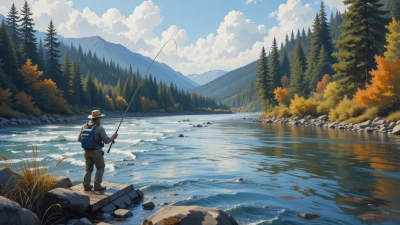Nehalem River Steelhead Fishing
Nehalem River Steelhead Fishing – Discover the best seasons, fishing spots, techniques, and expert tips to catch steelhead in Oregon's scenic Nehalem River.

Introduction to Steelhead Fishing on the Nehalem River
Located in the heart of Oregon’s coastal range, the Nehalem River is a hidden gem for steelhead anglers. Stretching over 100 miles, the river provides diverse habitat that attracts both winter-run and summer-run steelhead. Its clean, cold waters, easy access, and rugged beauty make it a favorite for locals and seasoned steelheaders alike.
Unlike salmon, steelhead are sea-run rainbow trout, and their strength and acrobatics make for an exhilarating fishing experience. Whether you're casting from the bank or floating in a drift boat, Nehalem River Steelhead Fishing promises heart-pounding action.
Understanding Steelhead Species
Winter-run vs Summer-run Steelhead
The Nehalem River is primarily known for its winter steelhead run, which begins in December and peaks through March. These fish return from the ocean to spawn in the upper reaches, offering anglers a chance at powerful, chrome-bright fish.
Although summer-run steelhead exist in some Oregon rivers, they are rarely found in the Nehalem, making winter the prime focus for steelheaders here.
Life Cycle and Migratory Patterns
Steelhead spend 1–3 years in the ocean before returning to freshwater. Unlike salmon, they can survive spawning and may return to the sea and spawn multiple times. Understanding their life cycle helps anglers predict behavior and movement during different river conditions.
Prime Seasons for Steelhead Fishing on the Nehalem River
Timing is key in steelhead fishing. The best time to fish the Nehalem River is:
| Month | Steelhead Activity | Conditions |
|---|---|---|
| December | Start of winter run | Rain-swollen rivers |
| January | Peak fishing period | Cold water, ideal for drift fishing |
| February | Still strong fishing | Fish spread throughout system |
| March | Tapering run | Low-clear water, stealth is crucial |
Watch for rising river levels after rain—steelhead often move upstream during these freshets.
Best Fishing Locations on the Nehalem River for Steelhead
Upper Nehalem (Vernonia to Spruce Run)
Ideal for bank fishing and drift boats. Features gravel beds, deep holes, and riffles—perfect steelhead habitat.
Middle Nehalem (Spruce Run to Foss)
Heavily forested and slightly more remote, this section is productive during mid-run season and offers classic steelhead water.
Access Points
- Spruce Run Park: Good trails and bank access
- Hoffman Bridge: Easy access and good bank fishing
- Nehalem Hatchery Area: Near prime holding water for hatchery fish
Top Steelhead Fishing Techniques
- Drift Fishing with Bait: Use roe, shrimp, or yarn balls. Cast upstream and bounce bait naturally along the bottom.
- Float Fishing: Bobber and jig setups are effective in deeper pools and slow currents.
- Bobber Dogging: A hybrid technique allowing for precise presentations in soft water.
- Plunking: In high water, stationary rigs with spin-n-glos and bait work well.
Recommended Tackle and Gear Setup
- Rod: 9'6" to 10'6" medium/light spinning or casting rod
- Reel: Smooth-drag spinning or baitcasting reel
- Line: 12–15 lb mainline with 8–10 lb fluorocarbon leader
- Hooks: Size 2–4 for bait rigs, size 6–8 for jigs
-
Popular Baits/Lures:
- Pink worms
- Corkies and yarn
- Beads
- Marabou jigs
Tip: Go lighter in low-clear water for more hookups.
Fly Fishing for Steelhead on the Nehalem
Fly fishing is growing in popularity. Focus on slower tail-outs and transition zones.
-
Effective Flies:
- Egg-sucking leech
- Purple Spey patterns
- Intruders in black, blue, or pink
Both single-hand and Spey casting are effective, depending on the size of the river section and cover.
Steelhead Behavior and How to Read the Water
Steelhead prefer:
- Holding water: Deeper pools with a soft current edge
- Transition zones: Where fast and slow currents meet
- Cover: Rocks, submerged logs, and shadows from overhanging trees
In high water, they hug the banks. In low water, they move early and late in the day.
Fishing Etiquette and River Safety
- Yield space: Give other anglers room, especially on popular stretches.
- Observe signs: Watch for posted property lines.
-
Stay safe:
- Always wear a wading belt
- Use polarized glasses to see underwater structures
- Never fish alone in remote sections during storms
Regulations, Permits & Legal Guidelines
You must follow ODFW rules, including:
- License Requirements: Oregon angling license + Combined Angling Tag
- Retention Limits: Usually 1–2 hatchery steelhead per day
- Wild Steelhead: Catch-and-release only
- Hook Restrictions: Barbless hooks may be required in certain areas